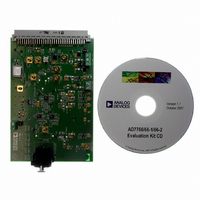EVAL-AD7766-1EDZ Analog Devices Inc, EVAL-AD7766-1EDZ Datasheet - Page 20

EVAL-AD7766-1EDZ
Manufacturer Part Number
EVAL-AD7766-1EDZ
Description
BOARD EVAL AD7766-1 64KSPS 111DB
Manufacturer
Analog Devices Inc
Specifications of EVAL-AD7766-1EDZ
Number Of Adc's
1
Number Of Bits
24
Sampling Rate (per Second)
64k
Data Interface
Serial
Inputs Per Adc
1 Differential
Input Range
±VREF
Power (typ) @ Conditions
10.5mW @ 64kSPS
Voltage Supply Source
Analog and Digital
Operating Temperature
-40°C ~ 105°C
Utilized Ic / Part
AD7766-1
Lead Free Status / RoHS Status
Lead free / RoHS Compliant
AD7766
DRIVING THE AD7766/AD7766-1/AD7766-2
The AD7766/AD7766-1/AD7766-2 must be driven with fully
differential inputs. The common-mode voltage of the differential
inputs to the AD7766/AD7766-1/AD7766-2 devices, and therefore
the limits on the differential inputs, is set by the reference voltage
(V
AD7766/AD7766-1/AD7766-2 is V
AD7766-1/AD7766-2 V
ADR435, or ADR425), the common mode is at 2.5 V, meaning
that the maximum inputs that can be applied on the AD7766/
AD7766-1/AD7766-2 differential inputs are a 5 V p-p input
around 2.5 V.
An analog voltage of 2.5 V supplies the AD7766/AD7766-1/
AD7766-2 AV
allow the user to apply a reference voltage of up to 5 V. This
provides the user with an increased full-scale range, offering the
user the option of using the AD7766/AD7766-1/AD7766-2 with
a greater LSB voltage. Figure 39 shows the maximum inputs to
the AD7766.
DIFFERENTIAL SIGNAL SOURCE
An example of recommended driving circuitry that can be used
in conjunction with the AD7766 is shown in Figure 40. Figure 40
shows how the
to the AD7766 from a differential source. Each of the differential
paths is driven by an ADA4841-1 device.
SINGLE-ENDED SIGNAL SOURCE
For applications using a single-ended analog signal, either
bipolar or unipolar, the ADA4941-1 single-ended-to-differential
driver creates a fully differential input to the AD7766. The
schematic is shown in Figure 41.
Table 8. Resistor Values Required When Using the Differential-to-Single-Ended Circuit with ADA4941 (See Figure 41)
V
+20, −20
+10, −10
+5, −5
IN
REF+
(V)
) applied to the device. The common-mode voltage of the
Figure 39. Maximum Differential Inputs to the AD7766
V
V
V
V
V
2.5
2.5
2.5
0V
0V
DD
REF
REF
REF
REF
2
2
OFFSET1
ADA4841-1
pin. However, the AD7766/AD7766-1/AD7766-2
(V)
REF+
pin has a 5 V supply (using ADR445,
device can be used to drive an input
V
2.203
2.000
1.667
OFFSET2
REF+
(V)
/2. When the AD7766/
V
V
IN+
IN–
OUT+ (V)
−0.01, +4.96
0.01, 4.99
0.00, 5.00
Rev. C | Page 20 of 24
OUT− (V)
5.01, 0.04
4.99, 0.01
5.00, 0.00
R1 and R2 set the attenuation ratio between the input range and
the ADC range (V
the desired input resistance, signal bandwidth, antialiasing, and
noise contribution. The ratio of R2 to R1 should be equal to the
ratio of REF to the peak-to-peak input voltage. For example, for
the ±10 V range with a 4 kΩ impedance, R2 = 1 kΩ and R1 = 4 kΩ.
R3 and R4 set the common mode on the V
set the common mode on the V
mode, which is equal to the voltage present at V
close to V
ratio of V
AIN+
AIN–
*SEE V
REFERENCE
V
IN
R5
VOLTAGE
R3
100nF
100nF
REF+
V
R1
Figure 40. Driving the AD7766 from a Fully Differential Source
R1 (kΩ)
8.06
4.02
2
OFFSET2
Figure 41. Driving the AD7766 from a Single-Ended Source
OFFSET1
INPUT SIGNAL SECTION FOR DETAILS.
V
REF+
OFFSET1
/2. The voltage present should roughly be set to the
1kΩ
1kΩ
1kΩ
1kΩ
to 1 + R2/R1.
FB
REF
IN
R6
R4
REF+
R2 (kΩ)
1
1
1
–0.2V
5.2V
). R1, R2, and C
0.1µF
ADA4841-1
ADA4841-1
ADA4941-1
R2
C
F
3.3nF
3.3nF
1kΩ
1kΩ
OUTN
OUTP
V
IN
IN+
100µF
R4 (kΩ)
12.7
15
20
ADR445
ADR425
input of the ADC. The common
15Ω
15Ω
15Ω
15Ω
F
are chosen depending on
VOUT = 5V REF
IN−
2.2nF
2.2nF
0.1µF
R3 = R5 = R6 (kΩ)
10
10
10
input, and R5 and R6
2.2nF
2.2nF
OFFSET1
4
5
2.5V TO 5V
V
V
V
V
IN+
IN–
IN+
IN–
AGND
, should be
ADP3330-2.5
V
AD7766
REF+
AD7766
2.5V
ADR4xx
ADP3330-2.5
V
AV
REF+
DGND
1
2
DD
AV
2.5V
LDO
DD
*


















